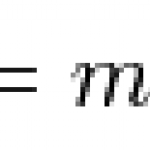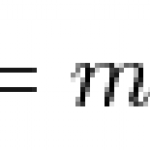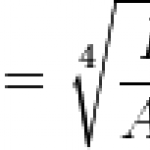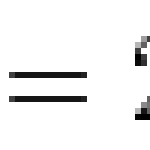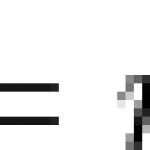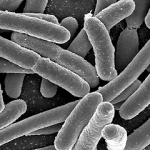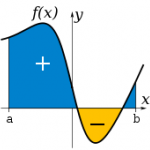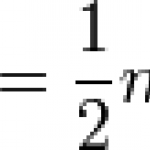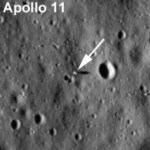All this week we're going to be briefly looking at James Clerk Maxwell's greatest contribution to physics - his theory of electromagnetism. The consequences and applications of the theory fill many volumes, but the conceptual and mathematical foundations of the theory can be expressed as four short and relatively simple equations. These are Maxwell's equations, and though they're not as well-known in the pop culture as Einstein's mass-energy equations our modern world would be impossible without them.
The first equation describes magnetic charge:
In words, you'd say "The divergence of…

All right ladies and gentlemen, take out your calculators. Punch in the number 4. Whack the square root button. What do you get?
Unless I am badly mistaken, you're going to get the number 2. As you probably remember, the square of a number is just that number multiplied by itself: 3 squared gives 9, 4 squared gives 16, 1/2 squared gives 1/4, etc. The square root is the inverse of this process. It tells you what you have to square to get the given number. Two times two is four, so the square root of four is 2. You can plot the graph of the function to see what the square roots of…
The excellent readers of this blog have left numerous astute comments about the Nuke the Moon post, assessing the difficulty of knocking aside asteroids via nuclear explosions. The two most common themes are orbital mechanics and using the lunar mass itself in a sort of mass-driver configuration. Both are excellent points. The orbital mechanics are more trouble than I want to go through at the moment (though maybe later), but the lunar surface mass is easier pickings.
The equation I derived for impulse-per-nuke was this:
This is of course with dramatically simplifying assumptions,…
Graduate school is like the previous 16 years of school in that you learn things and take classes, at least for the first couple of years. On the other hand it's also much more like a regular job than the previous schooling. You do work that's unrelated to class, and you get paid. Maybe not a whole lot of pay, but it keeps a roof over your head and food on the plate. Roughly speaking the paycheck will come from one of two things: teaching assistantships or research assistantships. In the former you are involved in teaching classes/labs and grading the resulting work. In the latter you…
Reader Scott writes in with a question:
Okay, let's assume something knocked the moon out of its orbit and it is going to crash into the earth in an arbitrary amount of time. (7 days?)
You are humanity's last hope. You have the entire nuclear salvos of the USA and Russia at your disposal, which are being fitted to be capable of being launched into outer space and to reach the moon at another arbitrary rate. Your goal is to knock the moon back onto its original orbit by striking it from the side in such a way that will redirect its net force back to a position that will result in the moon…
P.Z. Myers is not happy about Obama's selection of Francis Collins to head the National Institutes of Health. Why? Well, as you probably know, Myers is an outspoken atheist and Collins is an outspoken Christian. Myers is happy to point out that his opposition is not due to Collins' beliefs per se:
Every single one of us that has come forward to voice our unhappiness with the nomination has given an argument that is not based on the simple private fact that a nominee prays or goes to church. Such a position would be insane and impractical; we live in a country that is at least 80% Christian…
A few days ago we calculated the radiative power output of a very radioactive source like cobalt-60. CCPhysicist suggests we also calculate its surface temperature. Sounds like a plan!
A radioactive plutonium pellet, glowing red hot. Still much less radioactive than our hypothetical cobalt.
It would be difficult to calculate the temperature of the sample by itself, as we have no clean way of determining how much energy escapes in the form of the various nuclear decay processes without heating the sample. Most but not all of the gamma rays will escape, very few of the beta rays will, and…
You know what's gonna happen? I'll tell you what's gonna happen. Troops are now forming behind the line of trees. When they come out, they'll be under enemy long-range artillery fire. Solid shot. Percussion. Every gun they have. Troops will come out under fire with more than a mile to walk. And still, within the open field, among the range of aimed muskets. They'll be slowed by that fence out there, and the formation - what's left of it - will begin to come apart. When they cross that road, they'll be under short-range artillery. Canister fire. Thousands of little bits of shrapnel wiping the…
I'm a bibliophile. I read books at an inordinate rate and have a tendency to buy them at an even faster rate. Here at Texas A&M I'm fortunate to have access to a library of more than four million volumes, a fantastic interlibrary loan service, and a breathtaking special collections library that among other things houses one of the largest and most comprehensive science fiction collections in the nation.
I also very much love the aesthetics of the physical books themselves, and if/when electronic books finally displace the old paper copies it will be a sad day. But it could also be the…
As a student I know that toward the end of the semester it's sometimes a struggle to pay attention and retain motivation. As a teacher I have to try to fight that tendency in whatever way I can. It's not necessarily possible to make a physics quiz entertaining, but sometimes they can at least be made interesting.
You have a baseball-sized lump of metallic cobalt-60. It's radioactive, and is thus spitting energy in all directions mostly in the form of beta and gamma radiation. Wrap it in a sufficiently thick lead shell and that radiative energy is going to be absorbed and converted to…
We're not too far from the end of the Physics 202 class I'm helping teach, and as we finish things out we're learning about the particle nature of light and the wave nature of matter. It's really the very basics of quantum mechanics. One of the applications of this kind of knowledge is the electron microscope.
Light microscopes have a problem. As a rule, you can't resolve features smaller than the wavelength of the light you're using. Since this might be in the neighborhood of 600 nanometers for visible light, you have no real hope of seeing smaller things, or even of seeing objects a few…
This weekend I was at the movies with my lovely significant other watching The Proposal (verdict: about what you'd expect). Unusually for a by-the-numbers romcom, the pre-film previews showed no fewer than two promising science fiction films.
Science fiction is difficult to cleanly describe - it's almost more of a flavor than a formula. The best I can do at the moment is to say that science fiction speculates on the consequences of some fundamental but scientifically plausible difference(s) between now and some other time. That time doesn't necessarily have to be the future, by the way.…
We've done a lot of discussion of the concept of integrals of a function here on this blog. Their definitions and applications are so broad as to defy any one-sentence description, but one of the most basic is the idea of the area under a curve. More precisely it's the signed area under the curve - that is, the area above the x-axis is counted as positive and the area under counts as negative. Stealing the image from Wikipedia, which communicates the concept well:
In some cases you might have a function that exhibits a particular kind of symmetry about the origin. On one side of the…
Roughly a week or so ago the ScienceBlogs front page was discussing the new online videos of the Feynman lectures. Somehow they found one of my old posts on the subject.
What I haven't really seen pointed out that the new online video isn't actually "the" Feynman Lectures. "The" lectures were given as an actual class for Caltech physics undergrads, and the point was to teach them physics. There's not a lot of point reiterating the detail in my old post, but the main thrust is that the lectures are not far removed from what you'd hear if you wandered into your local university intro physics…
Far be it from a ScienceBlog to bloviate insufferably about current events, but I suppose I should weigh in on the whole Henry Louis Gates thing. I suppose this because I've had a very similar thing once happen to me. First Gates' story, then mine.
The accounts of Gates and the arresting officer vary on several points, and each paints the other in a very poor light. From the points of agreement we can reconstruct a minimal but probably accurate recounting of the events. Gates and his driver arrived at Gates' home. They could not easily get the door open either as a result of malfunction…
Here's a neat little news article about humans glowing in the dark.
The human body literally glows, emitting a visible light in extremely small quantities at levels that rise and fall with the day, scientists now reveal.
Past research has shown that the body emits visible light, 1,000 times less intense than the levels to which our naked eyes are sensitive. In fact, virtually all living creatures emit very weak light, which is thought to be a byproduct of biochemical reactions involving free radicals.
We're all glowing all the time throughout the entire spectrum as per Planck's law. The…
This week the science blogosphere has been spending a lot of time on space exploration and the science of understanding the universe outside our own planet. At risk of being the buzzkill distracting from all the cool space travel history and heated debates about NASA's future, I think it will be interesting to do a little bit of the math behind basic rocketry. As a bonus, we'll do it in the Lagrangian formulation of classical mechanics. (And maybe to draw in a few Google hits from lost students, I'll note that this is pretty much Goldstein 1.13) Non-mathy readers don't have to worry about…
There's been some discussion around the web of Jupiter apparently getting walloped by something, probably a comet. As with the more famous Shoemaker-Levy 9 impact, the result is a small dark blot in the clouds of the Jovian upper atmosphere. Small is a relative term - small spots on the surface can easily be as big as the Earth or bigger. Impacts are some of the most violent events in the solar system, and they release their energy entirely via conversion from kinetic energy.
Here on earth people sometimes discuss the history of high energy weapons in terms of energy per weapon mass.…
Forty years ago two human beings traveled a quarter million miles in a tiny metal capsule and stepped out onto the surface of the Moon. It was the most dramatic footfall in the history of our species, I am in absolute awe of all the Apollo program accomplished. Though it's a long shot, I'm hopeful that space tourism will become practical and inexpensive enough that someday I can be maybe the millionth or so person to stand on our sister world and look back at home.
Until then, I can just admire the pictures just taken by the Lunar Reconnaissance Orbiter of some of the old Apollo sites…
At the time I write this sentence it's 10:13 pm. The sun has been under the horizon for almost two hours. It's 93 degrees Fahrenheit outside here in College Station. I believe it peaked out right at 100 during the day, and it feels hotter in the sun. Even the animals are clearly not pleased.
Some of them are the cutest thermometers I've ever seen:
I wish I had taken a picture so I could show you exactly how the thermometer works. Fortunately there's nothing that's not on the internet, and other people have documented this particular phenomenon on film. The thermometer is a binary state…


